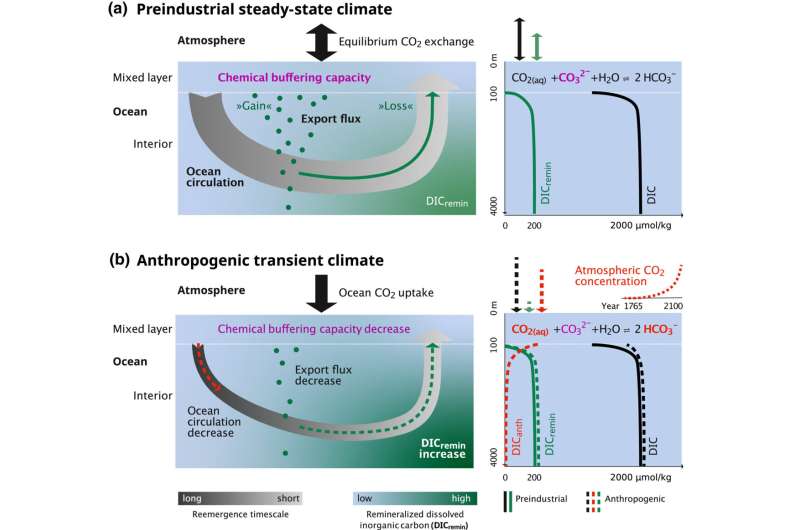This article has been reviewed according to Science X's editorial process and policies. Editors have highlighted the following attributes while ensuring the content's credibility:
fact-checked
peer-reviewed publication
trusted source
proofread
Researchers call for a comprehensive view of the marine biological carbon pump and its role in climate change

The ocean plays a crucial role in the storage of carbon dioxide (CO2). The so-called marine biological carbon pump is an important research topic in this context. However, according to Dr. Ivy Frenger, climate researcher at the GEOMAR Helmholtz Center for Ocean Research in Kiel, a key component is often overlooked.
In an opinion paper, she and international colleagues outline why it is insufficient to focus solely on biological processes when investigating the accumulation of CO2 in the ocean by the biological carbon pump. They argue that the co-occurrent return of CO2 to the atmosphere through ocean circulation must also be considered. The paper is published in the journal Global Change Biology.
The ocean contains about 60 times more carbon than the atmosphere, in part due to a key process in the marine carbon cycle called the biological carbon pump (BCP). In this process, carbon dioxide (CO2) is converted to organic matter through photosynthesis and subsequently sinks as the so-called "export flux" from the surface ocean waters to the deep sea.
As it sinks, bacterial decomposition processes break down the organic matter back into inorganic carbon, thus storing CO2 in the interior ocean. The BCP keeps atmospheric CO2 levels significantly lower than they would be in a hypothetical world without the BCP.
So far, so good. But one crucial aspect is often overlooked, says Dr. Ivy Frenger, a climate researcher at the GEOMAR Helmholtz Center for Ocean Research Kiel. "You have to consider the ocean circulation, because it determines how much of the biologically produced CO2 can actually accumulate in the interior ocean in the long term, isolated from exchange with the atmosphere."
Looking at the effect of the BCP only in terms of the export flux is like trying to explain the balance of a bank account by looking only at the deposits. "But there are gains and losses."
Changes in the BCP are an important research topic in the context of climate change. Ivy Frenger notes that when considering the impact of the BCP on atmospheric CO2, it is common to focus on the export flux and neglect the ocean circulation. She and six international colleagues have therefore published an opinion paper titled "Misconceptions of the marine biological carbon pump in a changing climate: Thinking outside the 'export' box."
In their paper, the scientists aim to address the misconception that there is a direct link between the global export flux—equivalent to deposits—and the biogenic storage of CO2 in the ocean, and hence, atmospheric CO2—the equivalent to the bank account balance. "There is no such simple correlation," says Dr. Frenger. The "withdrawal" side also needs to be taken into account.
A much simpler and scientifically more accurate approach, she says, would be to directly estimate the CO2 reservoir resulting from biological processes in the interior ocean. Such an estimate can be made by measuring the oxygen content of the ocean's interior along with its physical state, such as temperature.
Changes in these variables under climate change would also explain a seemingly paradoxical response of the BCP under anthropogenic climate change. Despite a decreasing export flux, carbon storage due to the biological pump in the interior ocean increases. This is because changes in ocean circulation delay the return of biologically stored carbon from the ocean interior to the surface.
As in the bank account analogy, while the deposits are lower, if the withdrawals are reduced to an even greater extent there will be a net increase. Accordingly, for climate change, this feedback results in more CO2 being stored in the ocean's interior than would be the case without the biological carbon pump.
Co-author Angela Landolfi remarks, "It is important to note that this effect is small when compared to the continuing massive anthropogenic CO2 emissions from fossil fuels."
The scientists hope that their opinion paper and proposed approach will contribute to a clearer understanding of the influence of the marine biological carbon pump on atmospheric CO2 in a changing world. A broader view of the biological carbon pump is particularly important for proposals to remove CO2 from the atmosphere through marine CDR approaches, such as artificially stimulating marine biology.
More information: Ivy Frenger et al, Misconceptions of the marine biological carbon pump in a changing climate: Thinking outside the "export" box, Global Change Biology (2024). DOI: 10.1111/gcb.17124
Journal information: Global Change Biology
Provided by Helmholtz Association of German Research Centres




















